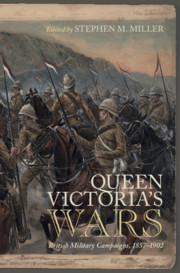Book contents
- Queen Victoria’s Wars
- Queen Victoria’s Wars
- Copyright page
- Contents
- Maps
- Contributors
- Acknowledgements
- 1 Introduction
- 2 The Indian Rebellion, 1857–1858
- 3 Punitive Expeditions in China, 1857–1860
- 4 The Expedition to Abyssinia, 1867–1868
- 5 The New Zealand Wars, 1845–1872
- 6 The Third Anglo-Asante War, 1873–1874
- 7 The Second Afghan War, 1878–1880
- 8 The Anglo-Zulu War, 1879
- 9 The First Anglo-Boer War, 1880–1881
- 10 Egypt and the Sudan, 1881–1885
- 11 The Third Anglo-Burmese War and the Pacification of Burma, 1885–1895
- 12 The Tirah Campaign, 1897–1898
- 13 Reconquest of the Sudan, 1896–1898
- 14 The South African War, 1899–1902
- 15 Conclusion
- Index
- References
12 - The Tirah Campaign, 1897–1898
Published online by Cambridge University Press: 01 June 2021
- Queen Victoria’s Wars
- Queen Victoria’s Wars
- Copyright page
- Contents
- Maps
- Contributors
- Acknowledgements
- 1 Introduction
- 2 The Indian Rebellion, 1857–1858
- 3 Punitive Expeditions in China, 1857–1860
- 4 The Expedition to Abyssinia, 1867–1868
- 5 The New Zealand Wars, 1845–1872
- 6 The Third Anglo-Asante War, 1873–1874
- 7 The Second Afghan War, 1878–1880
- 8 The Anglo-Zulu War, 1879
- 9 The First Anglo-Boer War, 1880–1881
- 10 Egypt and the Sudan, 1881–1885
- 11 The Third Anglo-Burmese War and the Pacification of Burma, 1885–1895
- 12 The Tirah Campaign, 1897–1898
- 13 Reconquest of the Sudan, 1896–1898
- 14 The South African War, 1899–1902
- 15 Conclusion
- Index
- References
Summary
The North-West Frontier of British India was the site of continuous Pukhtun armed struggle against colonial intrusion throughout the nineteenth century. Persistent tribal armed attacks and major rebellions were followed by 'butcher and bolt' or 'burn and scuttle' British military expeditions, including one of the biggest Victorian 'small wars', the Tirah Campaign of 1897–99. The campaign was undertaken to recover imperial prestige lost due to the fall of the strategically important Khyber Pass in August 1897. Lacking topographical knowledge, the British had to march a large force through rugged mountainous terrain without roads or tracks. Considering the historiography to date and relevant recent scholarship as well as shifting paradigms such as the New Military History, this chapter will offer a critical reappraisal of the Tirah Campaign including as an anatomy of battle, the infamous battle for the Dargai bluff, which the British captured on 18 October, abandoned it later that day, and then re-took again two days later. This re-examination of the Tirah war opens up a rich space to question the framework of small wars as it has been applied to such colonial wars.
Keywords
- Type
- Chapter
- Information
- Queen Victoria's WarsBritish Military Campaigns, 1857–1902, pp. 240 - 259Publisher: Cambridge University PressPrint publication year: 2021
References
Further Reading
- 3
- Cited by

